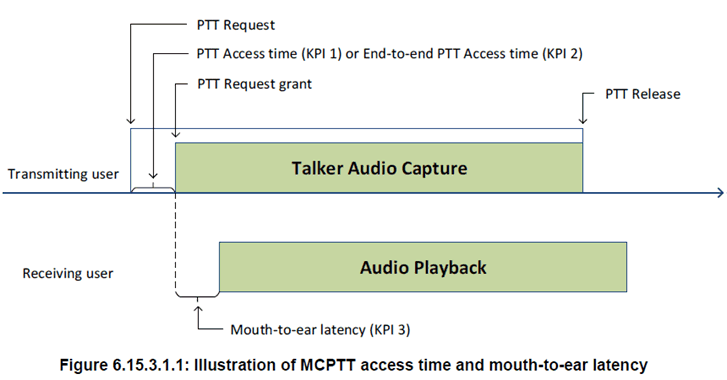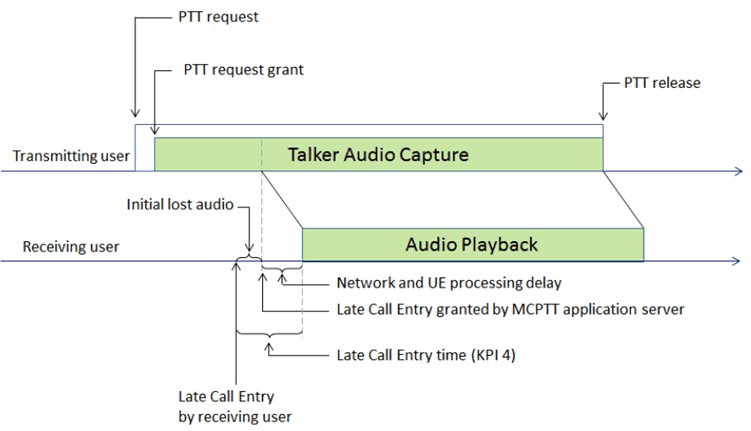Content for TS 22.179 Word version: 19.2.0
6.12 Location
6.13 Security
6.13.1 Overview
6.13.2 Cryptographic protocols
6.13.3 Authentication
6.13.4 Access control
6.13.5 Regulatory issues
6.14 Interactions for MCPTT Group Calls and MCPTT Private Calls
6.15 Audio MCPTT call performance
6.15.1 General overview
6.15.2 General requirements
6.15.3 MCPTT access time and mouth-to-ear latency
6.15.3.1 General overview
6.15.3.2 Requirements
6.15.4 Late call entry performance
6.15.4.1 General overview
6.15.4.2 Requirements
6.15.5 Audio / voice quality
6.15.6 Radio Resource Efficiency Performance
...
...
6.12 Location p. 50
[R-6.12-001]
Void
[R-6.12-002]
Void
[R-6.12-003]
Void
[R-6.12-004]
Void
[R-6.12-005]
Void
[R-6.12-006]
Void
[R-6.12-007]
Void
6.13 Security p. 50
6.13.1 Overview p. 50
Security covers areas designed to protect the confidentiality, integrity, and availability of information that is processed, stored, and transmitted. The security requirements listed here cover the areas of cryptographic protocols, authentication, access control, and regulatory issues.
6.13.2 Cryptographic protocols p. 50
[R-6.13.2-001]
Void
[R-6.13.2-002]
Void
[R-6.13.2-003]
Void
6.13.3 Authentication p. 50
[R-6.13.3-001]
Void
6.13.4 Access control p. 51
[R-6.13.4-001]
Void
[R-6.13.4-002]
Void
[R-6.13.4-003]
Void
[R-6.13.4-004]
Void
[R-6.13.4-005]
Void
[R-6.13.4-006]
Void
[R-6.13.4-007]
Void
[R-6.13.4-008]
Void
[R-6.13.4-009]
Void
[R-6.13.4-010]
Void
6.13.5 Regulatory issues p. 51
[R-6.13.5-001]
Void
6.14 Interactions for MCPTT Group Calls and MCPTT Private Calls p. 51
[R-6.14-001]
Void
[R-6.14-002]
Void
[R-6.14-003]
The MCPTT Service shall only allow an MCPTT User to participate in one MCPTT Private Call (without Floor control) at a time.
6.15 Audio MCPTT call performance p. 51
6.15.1 General overview p. 51
Meeting the KPIs defined in the following subclauses is based on a number of factors, including the selection of appropriate protocols, minimizing messaging, the backhaul technology used, and appropriate configuration of the deployed network. The corresponding requirements are intended to convey the resulting KPIs when all of those factors are taken into account. For example, where there is significant backhaul delay, that delay is expected to be added to the KPIs.
6.15.2 General requirements p. 51
[R-6.15.2-001]
The architecture and protocols providing the MCPTT Service shall be designed in a way to eventually allow a deployed network to meet the KPIs specified hereafter (subclause 6.15.3.2 and subclause 6.15.4.2).
6.15.3 MCPTT access time and mouth-to-ear latency p. 51
6.15.3.1 General overview p. 51
For MCPTT Users, one of the most important performance criteria is the MCPTT Access time (KPI 1). The MCPTT Access time is defined as the time between when an MCPTT User request to speak (normally by pressing the MCPTT control on the MCPTT UE) and when this user gets a signal to start speaking. This time does not include confirmations from receiving users.
The MCPTT Access time (KPI 1) does not include the time for an MCPTT User to affiliate to the group. This is a common scenario within public safety, meaning that affiliations to MCPTT Groups are long lived during several working hours. KPI 1 is applicable in both an MCPTT Group call setup request and subsequent MCPTT Requests that are part of the same call. KPI 1 for subsequent MCPTT Requests might take a slightly shorter time than the first MCPTT setup request of the same call due to its potential need of resource allocation in terms of bearer establishment. However from an end user perspective there is no need to differentiate required performance for an MCPPT Group call setup request and subsequent MCPTT Requests.
The End-to-end MCPTT Access time (KPI 2) is defined as the time between when an MCPTT User requests to speak (normally by pressing the MCPTT control on the MCPTT UE) and when this user gets a signal to start speaking, including MCPTT call establishment (if applicable) and possibly acknowledgement from first receiving user before voice can be transmitted. Group calls can be set up with or without acknowledgements from receiving users.
For MCPTT Private Calls (with Floor control), end-to-end MCPTT Access time (also KPI 2) is measured from the initiating client's Private call request to reception of either a Private Call response for automatic commencement or the MCPTT ringing indication for manual commencement. End-to-end access time for both automatic and manual commencement private calls (KPI 2) is shown in Figure 6.15.3.1-1.
The Mouth-to-ear latency (KPI 3) is the time between an utterance by the transmitting user, and the playback of the utterance at the receiving user's speaker. Figure 6.15.3.1-1 illustrates the MCPTT Access time and Mouth-to-ear latency.

Figure 6.15.3.1-1: Illustration of MCPTT access time and mouth-to-ear latency
(⇒ copy of original 3GPP image)
(⇒ copy of original 3GPP image)
6.15.3.2 Requirements p. 52
[R-6.15.3.2-001]
KPI 1, KPI 2, and KPI 3 should be measured where there is negligible backhaul delay.
[R-6.15.3.2-002]
The MCPTT Service shall provide the MCPTT Access time and Mouth-to-ear latency specified in this subclause to all MCPTT Users related to an MCPTT call regardless of call type (e.g., group, Private Call), group size and/or user density.
[R-6.15.3.2-003]
The MCPTT Service shall be capable of providing the performance specified herein for all Affiliated MCPTT Group Members in the Group Call when there is not a transcoder in the bearer path.
[R-6.15.3.2-004]
The MCPTT Service shall be capable of providing the performance specified herein for all Participants in a Private Call when there is not a transcoder in the bearer path.
[R-6.15.3.2-005]
The KPIs defined in this subclause shall apply in an 3GPP network under traffic load not exceeding 70% of each network nodes capacity.
[R-6.15.3.2-006]
On networks with QOS services, the KPIs defined in this subclause shall apply when the total sector loading of the serving sector by MCPTT Users with equal or greater priority than the subject MCPTT User is less than 70%.
[R-6.15.3.2-007]
The KPIs defined in this subclause shall apply to group calls when the transmitting MCPTT User is connected to the MCPTT Service and has selected an MCPTT Group.
[R-6.15.3.2-008]
The KPIs defined in this subclause shall apply to group calls when the receiving MCPTT User is connected to the MCPTT Service and affiliated with the MCPTT Group.
[R-6.15.3.2-009]
The KPIs defined in this subclause shall apply to Automatic Commencement Private Calls when both the transmitting and receiving MCPTT Users are connected to the MCPTT Service.
[R-6.15.3.2-010]
Void
[R-6.15.3.2-011]
When there are transcoding functions in the bearer path of the MCPTT Service, the performance provided by the MCPTT Service shall be no more than 40 ms greater than the performance specified herein when there are no transcoding functions in the bearer path.
[R-6.15.3.2-012]
For group calls where no acknowledgement is requested from affiliated MCPTT group members, the MCPTT Service shall provide an MCPTT Access time (KPI 1) less than 300 ms for 95% of all MCPTT Request.
[R-6.15.3.2-012a]
For group and private calls where the call is already established, the MCPTT Service shall provide an MCPTT Access time (KPI 1) less than 300 ms for 95% of all MCPTT PTT Requests.
[R-6.15.3.2-013]
For MCPTT Emergency Group Calls and Imminent Peril Calls the MCPTT Service shall provide an MCPTT Access time (KPI 1) less than 300 ms for 99% of all MCPTT Requests.
[R-6.15.3.2-014]
For group calls where automatic acknowledgement is requested from the UEs of the affiliated MCPTT group members, the MCPTT Service shall provide an End-to-end MCPTT Access time (KPI 2) less than 1000 ms for users under coverage of the same network.
[R-6.15.3.2-015]
The MCPTT Service shall provide a Mouth-to-ear latency (KPI 3) that is less than 300 ms for 95% of all voice bursts.
[R-6.15.3.2-016]
There shall be no (0 ms) initial lost audio at receiving user.
[R-6.15.3.2-017]
There shall be no (0 ms) trailing lost audio at the end of the voice burst at receiving user. [R-6.15.3.2-018] The KPIs defined in this subclause shall apply to Manual Commencement Private Calls when both the transmitting and receiving MCPTT Users are connected to the MCPTT Service.
[R-6.15.3.2-019]
The MCPTT Service shall provide private call End-to-end MCPTT Access time (KPI 2) equal to or less than 1000 ms for users under coverage of the same network when the MCPTT private call is setup in the Manual Commencement mode.
[R-6.15.3.2-020]
The MCPTT Service shall provide private call End-to-end MCPTT Access time (KPI 2) equal to or less than 1000 ms for users under coverage of the same network when the MCPTT private call is setup in the Automatic Commencement mode.
6.15.4 Late call entry performance p. 53
6.15.4.1 General overview p. 53
An MCPTT User is able to join or leave already ongoing MCPTT Group calls. Late call entry is the activity when an Affiliated MCPTT Group Member joins an MCPTT Group call in which other Affiliated MCPTT Group Members are already active. The Late call entry time (KPI 4) is the time to enter an ongoing MCPTT Group call measured from the time that a user decides to monitor such an MCPTT Group Call, to the time when the MCPTT UE's speaker starts to play the audio. The performance requirements for Late call entry time only applies to when there is ongoing voice transmitted at the time the MCPTT User joins the call.
In a Late call entry there might be an initial lost audio of the voice burst sent to the new Receiving MCPTT Group Member. Figure 6.15.4.1-1 illustrates the Late call entry time.

6.15.4.2 Requirements p. 54
[R-6.15.4.2-001]
The KPIs in this subclause shall apply for terrestrial use only, and when users are under coverage of the same network.
[R-6.15.4.2-002]
The KPIs defined in this subclause shall apply in an 3GPP network under traffic load not exceeding 70% of each network nodes capacity.
[R-6.15.4.2-002a]
The KPIs defined in this subclause shall apply to MCPTT users who have affiliated or have been affiliated by the network and are now performing late call entry due to activity on the affiliated group.
[R-6.15.4.2-003]
The maximum Late call entry time (KPI 4a) for calls without application layer encryption within one MCPTT system shall be less than 150 ms for 95% of all Late call entry requests.
[R-6.15.4.2-004]
The maximum Late call entry time (KPI 4b) for application layer encrypted calls within one MCPTT system should meet the requirements for KPI 4 for unencrypted calls.
[R-6.15.4.2-005]
The maximum Late call entry time (KPI 4b) for application layer encrypted calls within one MCPTT system shall be less than 350 ms for 95% of all Late Call Entries into encrypted calls.
[R-6.15.4.2-006]
The Late call entry Time for encrypted calls interworking with other non-3GPP PTT systems should meet the requirements for KPI 4b for application layer encrypted calls within one MCPTT system.
[R-6.15.4.2-007]
The additional Late call entry Time for an MCPTT UE late entering an application layer encrypted call interworking with other non-3GPP PTT systems shall not exceed the difference in the encrypted and unencrypted Late call entry Times for the interworking system.
6.15.5 Audio / voice quality p. 55
[R-6.15.5-001]
The MCPTT UE shall support at least one mandatory 3GPP voice codec.
[R-6.15.5-002]
When an MCPTT call is within one MCPTT system the average MOS-LQO shall be greater than or equal to 3.0 measured according to the ITU standard Perceptual Evaluation of Speech Quality (PESQ) as defined in P.862 [7] and P.862.1 [8].
[R-6.15.5-003]
When an MCPTT call involves interworking with other non-3GPP PTT systems the average MOS-LQO shall be greater than or equal to 2.7 measured according to the ITU standard PESQ as defined in P.862 [7] and P.862.1 [8].
[R-6.15.5-004]
When an MCPTT call is within one MCPTT system the average MOS-LQO shall be greater than or equal to 3.0 measured according to the ITU standard Perceptual Objective Listening Quality Assessment (POLQA) as defined in P.863 [9].
[R-6.15.5-005]
When an MCPTT call involves interworking with other non-3GPP PTT systems the average MOS LQO shall be greater than or equal to 2.7 measured according to the ITU standard POLQA as defined in P.863 [9].
6.15.6 Radio Resource Efficiency Performance p. 55
[R-6.15.6-001]
Void
[R-6.15.6-002]
Void